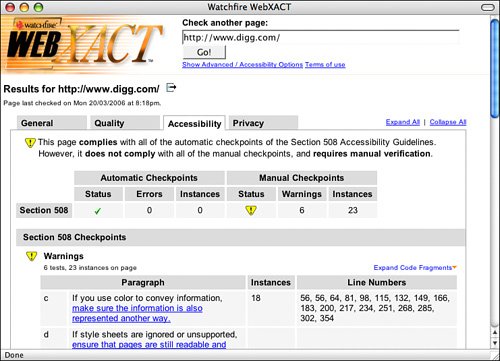Validating Your Sites for Accessibility
| There's no reason to rely on luck when it comes to determining whether your site measures up when it comes to accessibility. Just as you can use the W3C validator to verify that your HTML files are standards compliant, you can use the WebXACT, the accessibility validator, to determine how well a page complies with accessibility guidelines. The validator can be found at http://webxact.watchfire.com. It can validate a site against the Section 508 guidelines mentioned earlier, or against the Web Content Accessibility Guidelines developed by the W3C. Its operation is virtually identical to that of the HTML validator provided by the W3C. If you submit your page to the validator, it will generate a report that indicates which areas of your page need improvement, and will also provide general tips that can be applied to any page. It also prints out the full content of the page and adds in links to the report so that you can see exactly which places on the page the report refers to. Figure 17.5 is a screenshot of WebXACT's report on the digg.com page. Figure 17.5. An accessibility report generated by WebXACT. Another nice feature of WebXACT is that the report contains links to specific ways to address the issues it raises. For example, Figure 17.6 is the page that WebXACT links to when you have repetitive navigation links on a page. Figure 17.6. Advice from WebXACT on how to fix an accessibility issue. WebXACT is provided free of charge by Watchfire, which is in the business of providing website management tools. The downside of the free version is that it validates only one page at a time. This isn't as bad as it sounds because most larger sites have a lot of common markup from page to page so if you fix an issue in one place, you can often fix it on all of your pages. However, Watchfire also offers commercial versions of WebXACT that can be installed on a server or used by a single user to validate entire sites.
|
EAN: 2147483647
Pages: 305